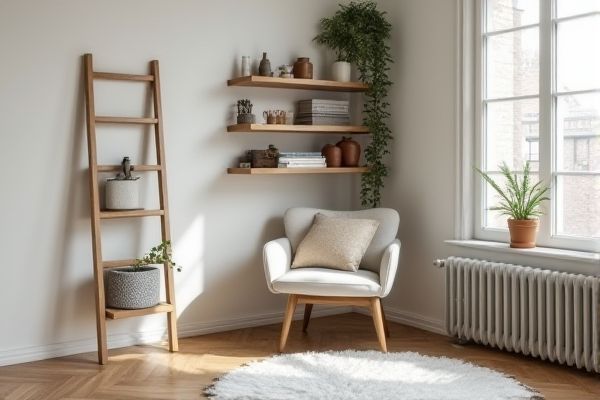
A corner shelf unit maximizes space efficiency by fitting snugly into room corners, providing discreet storage without occupying central floor area, while a ladder shelf leans against a wall, offering a stylish and open display with tiered shelves that are easily accessible. Explore the rest of the article to determine which shelving option best suits your storage needs and aesthetic preferences.
Table of Comparison
| Feature | Corner Shelf Unit | Ladder Shelf |
|---|---|---|
| Design | Fits into corner spaces, triangular or L-shaped shelves | Leaning structure, tiered shelves, open back |
| Space Utilization | Maximizes unused corner areas | Ideal for wall-adjacent spaces, less corner-efficient |
| Stability | Generally stable, fits snugly in corners | Leaning design may require wall anchoring for safety |
| Storage Capacity | Compact shelving, moderate storage | Multiple tiers, variable storage based on height |
| Style | Functional, space-saving, often minimalist | Trendy, decorative, modern aesthetic |
| Installation | Easy to place, usually freestanding | Requires leaning setup, sometimes wall mounting |
| Use Cases | Small rooms, offices, bathrooms, tight spaces | Living rooms, bedrooms, display areas |
| Material Options | Wood, metal, MDF | Wood, metal, bamboo |
Introduction to Corner Shelf Units and Ladder Shelves
Corner shelf units maximize space utilization by fitting snugly into room corners, offering practical storage and display options with a compact footprint. Ladder shelves feature a tiered design leaning against walls, providing an open, airy aesthetic ideal for showcasing books, decor, and plants while maintaining easy access. Both options enhance organization and style but differ in spatial placement and visual impact.
Space Utilization: Corner Shelf Unit vs Ladder Shelf
Corner shelf units maximize space utilization by fitting snugly into room corners, making use of often overlooked areas and freeing up central floor space. Ladder shelves, while more versatile and visually open, require wall clearance and floor space, which may limit their efficiency in smaller rooms. Your choice depends on whether optimizing every inch of corner space or maintaining flexible, accessible storage is more important for your room layout.
Design and Aesthetic Appeal
Corner shelf units maximize space efficiency with a compact design that fits snugly into room corners, offering a clean and minimalist aesthetic ideal for small or awkward spaces. Ladder shelves provide an open, tiered structure that creates a stylish, modern look with easy access to items, making them perfect for displaying decorative pieces and plants. Your choice depends on whether you prefer subtle integration or a visually striking display that enhances your room's overall design.
Material and Build Quality Comparison
Corner shelf units often feature sturdy wood or engineered wood construction with reinforced joints, providing durability for holding heavier items in tight spaces. Ladder shelves typically use lighter materials such as metal frames with wooden or composite shelves, emphasizing a sleek, open design but sometimes compromising weight capacity. Your choice depends on whether you prioritize robust build quality for maximum storage or a visually airy aesthetic that ladder shelves offer.
Storage Capacity and Organization
Corner shelf units maximize storage capacity by utilizing often-overlooked corner spaces, offering multiple enclosed or open compartments for organized storage of books, decor, and essentials. Ladder shelves provide a more open design with tiered shelves that prioritize display and easy access, making them ideal for organizing items you want visible and within reach. Your choice depends on whether you need compact, high-capacity storage or stylish, accessible organization.
Versatility and Placement Options
Corner shelf units maximize space efficiency by fitting snugly into room corners, making them ideal for smaller areas or awkward spaces. Ladder shelves offer versatile placement along walls, providing easy access and adjustable storage options for books, decor, or plants. Your choice depends on whether you prioritize space-saving corner use or open, flexible display arrangements.
Installation and Maintenance
Corner shelf units typically require wall mounting or securing to adjacent walls, demanding precise measurements for a snug fit in room corners, which may involve drilling and anchors for stability. Ladder shelves favor a freestanding design, enabling easy relocation without complex installation, though occasional tightening of screws and dusting between slats help maintain their upright structure and appearance. Your choice impacts not only ease of setup but also ongoing maintenance efforts tailored to your space and usage habits.
Cost and Value for Money
Corner shelf units generally offer better value for money due to their efficient use of often-unused corner space and affordable price range, making them ideal for maximizing storage in small rooms. Ladder shelves, while typically more expensive, provide a stylish and versatile design that can function as both shelving and decorative space, increasing your room's aesthetic appeal and potentially its resale value. Choosing between the two depends on whether you prioritize budget-friendly, space-saving functionality or a visually striking statement piece with broader uses.
Pros and Cons of Corner Shelf Units
Corner shelf units maximize unused corner spaces, offering efficient storage without occupying central floor area, making them ideal for small rooms. They provide stability due to their three-point support but may limit shelf width and accessibility compared to ladder shelves. However, corner shelves can be harder to install and less versatile in design options, potentially restricting aesthetic flexibility.
Pros and Cons of Ladder Shelves
Ladder shelves maximize vertical storage space with a stylish, open design that fits well in small rooms, providing easy access to books and decor. However, their slanted shelves limit storage capacity for larger or heavier items and may lack stability compared to corner shelf units anchored in room corners. Your choice depends on whether you prioritize aesthetic appeal and light storage or sturdy, space-efficient corner storage.
 homyna.com
homyna.com